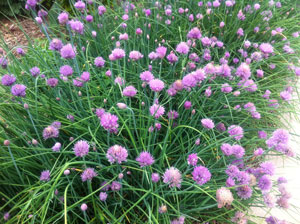Resource Library
Plant of the Week: Flowering Chives
The University of Arkansas System Division of Agriculture does not promote, support or recommend plants featured in "Plant of the Week." Please consult your local Extension office for plants suitable for your region.
Plant of the Week
Chives
Latin: Allium schoenoparasum

Unfortunately – even though the purveyors of fast and processed food argue vehemently against the charge – our dietary situation has devolved during the last generation to the point where two-thirds of us are rated as obese. Getting back to home cooked meals using food raised in our own back yards is a laudable goal but one that still has a ways to go before much a dent is made in the way we eat. Chives (Allium schoenoparasum) is an herb that makes up a small part of our diet but is one of the foods we should probably eat more.
Chives are a widely distributed member of the onion family that occurs throughout Europe and Central Asia. It is a clump-forming bulbous plant that forms slender, white, three-eighths-inch-wide bulbs that quickly form offsets and expand the size of the clump. The hollow green leaves grow about 14 inches tall and produce a mild onion flavor when eaten.
Flowers appear the second spring from seeding in a terminal umbel about 16 inches tall. The individual flowers are about a half-inch inch wide with six star-shaped purple petals. Twenty to 30 flowers are combined to form the head. Each clump produces a number of showy flower heads that begin appearing in late spring and continue on and off during the rest of the season. If the flower heads are allowed to remain on the plant a number of small black seeds are produced in a three-valved capsule.
This onion, unlike most of its kin, is grown for its mild flavored foliage, not its bulbs. It has been eaten for at least 5,000 years in most European countries. Looking at the translations of the word “chive” into various European languages, no commonality in word form is seen thus indicating the antiquity of the food in various cultures. The word “chive” is a Middle English word said to have been anglicized through French from the Latin word “cepa,” for onion. The Latin epitaph schoenoparasum is from Greek words and translates as “rush leek,” a reference to the round rush like leaves that taste like leek.
Chives are an easily grown pot herb useful for imparting a mild onion flavor to soups, salads and broths or – as I first became acquainted with them – as an ingredient to the fully loaded baked potato. They are available year round in grocery stores or can easily be grown in a corner of the vegetable garden or planted as a border plant in the flower garden. A few clumps will keep the average family in chives all year long.
They are best in full sun or light shade in average garden soil. They may be started by spring planted seed or by division of the clump at any season. Because the seedlings are small, grow the plants in a container until the transplant is large enough to move to the garden. To maintain a ready supply of greens from new growth, cut the plants back to within an inch or so of the ground. By staggering the cutback operation it will be possible to have fresh, succulent greens all season long. The bulbs are winter hardy from zone 4 through 9. By providing a protective covering during the coldest part of winter it is possible to have fresh chives year round in Arkansas. Seed heads should be removed before the seed crop has a chance to mature.
By: Gerald Klingaman, retired
Retired Extension Horticulturist - Ornamentals
Extension News - May 11, 2012
The University of Arkansas System Division of Agriculture does not maintain lists of retail outlets where these plants can be purchased. Please check your local nursery or other retail outlets to ask about the availability of these plants for your growing area.